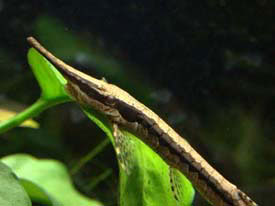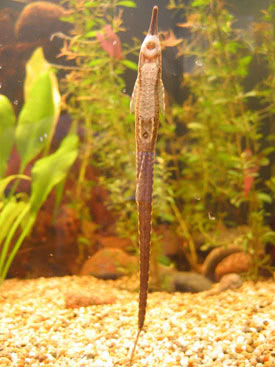
 Magyarul / Hungarian
Magyarul / Hungarian



- Scientific name: Farlowella acus
- Synonyms: Acestra acus
- Common name: Needle Catfish, Farlowella cat, Twig catfish
- Group: Catfishes
- Habitat: South America; Venezuela, southern tributaries of the Amazon.
- Size: 15 cm
- Biotope: Shallow shore areas of slow moving or standing water with heavy vegetation.
- Social behavior: Peaceful and shy, these fish are not suggested for a community tank where more active fish may fighten it.
- Diet: The fish is vegetarian, and may eat plants. Feed at night, because if fed during the day it may starve. Algae wafers should form the bulk of the diet.
- Breeding: Easy
- Tank: Minimum 120 litres
- Population: 3-4 fishes for 120 litres
- Decoration: This catfish prefers a deep tank that has bright lighting. Provide hiding places with wood, roots, and rocks. Water should be clear and high in dissolved oxygen. Substrate should be fine sand and rounded stones.
- Temperature: 24-26 °C
- pH: 5,8-7
- Hardness: 2-10 NK°
- Lifespan: 5-8 years
Description: The body of this catfish is elongated and extremely slender, and it has an extended snout. The sucking mouth is located on the underside of the head. Coloration ranges from olive-green to yellow-brown with yellowish undersides. On both sides of the body is a dark brown line which extends the length of the body. The fins are transparent and the rays have dark spots. Not recommended for a beginner. Fish may indicate poor water conditions or low oxygen content by poking its snout above the surface of the water. Twig catfishes do not handle sudden or large amounts of water changes very well.
Males and females are easily recognized by their beaklike protuberance. That of the male is wider and covered with lots of small bristles, that of the female is narrower and without bristles. Males will establish territories.
Hatching and breeding of Farlowella acus are rather simple, at least for an aquarist who has gathered experince with other catfishes. In the aquarium the male will clean a hard surface (usually the aquarium wall), before spawning. Spawning occurs at night or early in the morning, and 40-60 eggs are laid. At 26 °C the fry hatch after 4 days. The male watches and cares for the eggs, delivering the fry from the egg casings. The best hatching happens in oxygen-rich "old water" and under diffused light. The pH value should be natural, the hardness between 5-10 °dGH. Try feeding the fry with vegetables, tablets, and Artemia.

































